Insurers should bear in mind that fire claims are always large

Two very serious fires over the last insurance period has made it very clear to insurers in South Africa and perhaps further afield in the reinsurance industry the real danger that these large fires can present in terms of insured losses as well as the volume and complexity of claims investigation that results from such fires. The two fires I will look at is a major forest fire that broke out in the Knysna region of the Western Cape Province in South Africa. It is one of the most picturesque cities in South Africa on what is known as the garden route. There are many expensive holiday homes with many thatched roofs and not isolated from large contractors to rebuild housing and buildings.
With large winds and an exceptionally dry season an electrical cable that was blown over and was the cause for one of the most serious insured forest fires in South Africa’s history. Because of the large winds and hot weather the large flames were jumping over the large highway and literally the hot air was incinerating property on contact. Residents of houses literally had warnings of less than three minutes to leave their houses and take what little they could but literally their entire documented life’s collections were destroyed. The interesting issue was that not all houses were burnt, certainly the thatched rooves properties were but certain houses were simply skipped over. What followed though showed South Africa the importance of fore related insurance cover. Insurers not based in the area opened up claims offices, interim payments were authorised within days so residents could at least buy clothes and have access to residents to rent to get back on their feet. Insurers provided disclaimer boards for clients to erect on their property to make sure they would not be sued if anyone was injured on their dangerous building sites. Insurance is not just a financial services company designed to make profit, it contributes to society and when there is a one in a hundred year event, society is protected by what Insurance offers to restore and give back. In terms of learnings, an insurer must have plans for such an event, how would they respond if such an event happened to their clients. How can they assist the town in maintaining effective firefighting equipment?
The second claim was a very large fire in a warehouse at one of South Africa’s harbours. The warehouse had numerous tenants and the material damage together with the business interruption cover is set to make sure this will be one of South Africa’s largest property claims in the short term space. Such fires are becoming more and more common in South Africa at the moment given that warehouses and factories are not at this stage installing sprinkler systems that are specifically designed to protect premises of this nature. This would include having sprinklers with the right water pressure and serviced regularly by competent service personnel. It is also important to understand that office blocks and storage warehouses require very different sprinkler systems to be effective. Prudent insurer need to make sure they survey such properties carefully and demand that qualified fire engineers sign off the sprinkler systems before cover is granted.
The second issue that arose from this claim is that these fires often begin in relative innocuous ways such as minor welding alteration know in South Africa as “hot works”. Even small welding operations have the ability to create very large fires and insures again should try and state in their policies that all regulatory laws and by laws need to be observed before cover will be given. Many fires would have been prevented or certainly mitigated if by laws and regulations would have been adhered to. This could also be supervised through on-going surveys. One should always bear in mind fire claims are always large claims and Insurers should do all they can to prevent them as best as they can.
by Danny Joffe: Chairman of Klapton’s Ethics, Nominations & Remuneration Committee


